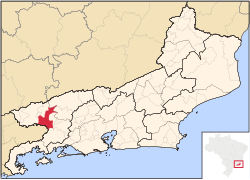This article needs additional citations for verification .(January 2021) |
Barra Mansa | |
|---|---|
| Municipality of Barra Mansa | |
 Location in Rio de Janeiro | |
| Coordinates: 22°32′38″S44°10′15″W / 22.54389°S 44.17083°W | |
| Country | |
| Region | Southeast |
| State | |
| Founded | 1832 |
| Area | |
• Total | 547.133 km2 (211.249 sq mi) |
| Elevation | 389 m (1,276 ft) |
| Population (2020) [2] | |
• Total | 184,833 |
| • Density | 337.821/km2 (874.952/sq mi) |
| Time zone | UTC-3 (UTC-3) |
| • Summer (DST) | UTC-2 (UTC-2) |
| Postal Code | 27355 |
| Area code | +55 24 |
| HDI (2010) | 0.729 – high [3] |
Barra Mansa is a municipality located in the Brazilian state of Rio de Janeiro.
Contents
It is in the microregion of the Paraíba Valley, within the mesoregion of the South Fluminense. It is located at latitude 22º32'39 "south, longitude 44º10'17" west and altitude of 381 meters. Its estimated population in 2020 was of 184,833 inhabitants, forming a conurbation with the cities of Volta Redonda and Pinheiral with a population of more than 450 thousand inhabitants. It has an area of 548.9 km2.
The administrative and legislative center is in the Centro district. In it are located the city hall and the City Hall). The judicial center is the Barbará neighborhood, where the municipal forum is located.
In 1954 the district of Volta Redonda was emancipated and, in 1991, it was Quatis's turn, taking with him the districts of Ribeirão de São Joaquim and Falcão. In 1993 Antônio Rocha was elevated to the condition of district, as well as the district Santa Rita de Cássia, in 2006.
The population of Barra Mansa is made up of descendants of European immigrants (mainly Portuguese, Italian, and Spanish), but also French and German, as well as a dynamic Syrian-Lebanese colony, as well as Amerindians and African descendants.
The municipality has the second largest population of the South Fluminense mesoregion, has more than 528 industrial units, a large rail, road and river junction. It is located in a privileged area, close to the two largest Brazilian cities: Rio de Janeiro and São Paulo. It is also close to regional economic centers such as São José dos Campos, Juiz de Fora and Volta Redonda. Barra Mansa has a per capita income above the national average of R $13,956.15 [5], and has a Human Development Index (HDI) considered high by the United Nations Development Program (UNDP) of 0.806 (year 2000). It is sixth in the ranking of best Human Development Index (HDI-M) among the municipalities of Rio de Janeiro.
Barra Mansa has a strong and traditional shopping center, vital to the municipality's economy.
Around 1700, arriving in São Paulo was an almost impossible task, because of the natural barrier created by the Serra do Mar. But for the trip to become faster, the governor Luís Vaía Monteiro ordered a way through the Itaguaí mountain range.
After completing the route, several incursions were made to the Paraíba do Sul River, but without the commitment to form villages or towns. These incursions were almost always made up of adventurers looking for gold. The first clue to settlement occurred in 1764 when Francisco Gonçalves de Carvalho obtained with the viceroy D. Antônio Álvares da Cunha a sesmaria to found a farm of cattle and supplies (Fazenda da Posse) between the Paraíba River of the South and the river Bananal, exactly in the place where there was a stream called Barra Seca or Barra Mansa.
In 1764, the Vice King of Brazil, Antônio Álvares da Cunha, granted a sesmaria to the farmer Francisco Gonçalves de Carvalho. Thus was born in these lands the first building of the Vila de São Sebastião da Barra Mansa. Built on the banks of the Barra Mansa River and the Paraíba do Sul River, the Posse farm, dating from 1768.
The Barão de Guapi Palace is a historical building of Barra Mansa that received illustrious people like the Princess Isabel. Already hosted the City Hall and the City Hall. It currently houses the Library. In 1765, José Alberto Monteiro also obtained from the viceroy a sesmaria on the bank of the Paraíba River, where it is today the city of Volta Redonda. Over the years, these sesmarias were changed owners, until, around 1827, they arrived, by inheritance, at the hands of Colonel Custódio Ferreira Leite, the Baron of Aiuruoca, founder of the municipality. From there, the site became the obligatory point of passage of troops of travelers on the way to seaports. In 1800, in the lands of Henrique Magalhães, very near the mouth of the river Barra Mansa, already existed a mill and a chapel. Gradually, a small population nucleus began to emerge and the beginning of the settlement encouraged Colonel Custódio Ferreira Leite, who had another chapel built on the right bank of the Paraíba, also dedicated to São Sebastião, located almost in front of Fazenda Ano Bom , on the opposite bank of the river.
The small village grew and on October 3, 1832, thanks to a letter addressed to the General Legislative Assembly of the Empire, the village of São Sebastião de Barra Mansa was created, becoming part of the village dismembered lands of the neighboring Resende, Valença and St. John Mark. In 1954, due to a political maneuver, it had emancipated the until then district of Santo Antônio de Volta Redonda and in 1991 the districts of Quatis, Falcão and Ribeirão de São Joaquim.








